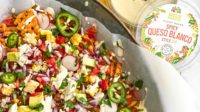In Search of Good Taste
November 15, 2024
In Search of Good Taste
November 15, 2024While convenience and versatility remain foundational for refrigerated and frozen foods, consumers now expect new flavors, formats and nutritional innovations, as food processors and manufacturers are increasingly challenged to meet clean label standards.
The flavor market is expected to grow at a compound annual growth rate (CAGR) of 5.9% through 2030 with a “shift toward diverse and unconventional flavor profiles… giving rise to the emergence of natural flavor enhancers made from botanical and fruit extracts,” according to Grand View Research.
Consumers increasingly seek premiumization from the cold case, challenging food companies to replicate the rich, authentic sensory experiences of home-cooked meals on a large scale while maintaining convenience.
“For cold food products like refrigerated or frozen items, flavors must remain stable and effective through the freezing, thawing, and chilling processes. This is particularly challenging because lower temperatures can dull certain flavor notes or alter the sensory experience compared to ambient foods. As a result, cold food companies often need to adjust flavor formulations to ensure that the desired taste remains vibrant and consistent from production to consumption,” said Matt McGuffey, product manager of savory and protein solutions at Givaudan Taste & Wellbeing. “Additionally, cold foods must be carefully balanced to maintain their organoleptic qualities—like texture and mouthfeel—since the physical state of ingredients can change during freezing or refrigeration. For example, freezing can affect the texture of sauces or the crispness of vegetables, so flavor and texture enhancers may be needed to deliver a consistent eating experience.”
Givaudan’s latest FlavourVision report identified consumer preferences, including what it calls Sensorial Renaissance (a desire for intensified sensory experiences, pushing boundaries) and Restorative Care (a focus on intuitive and restorative health practices).
“Sensorial Renaissance is particularly relevant to frozen food, which continues to be a household staple due to its ease of preparation and wide variety of options,” McGuffey said. “Mexican and Asian cuisines are especially popular, with flavors like the rich sweetness of churros, creamy Dulce de Leche, earthy turmeric, and bold Korean barbecue capturing consumer interest. At the same time, classic flavors are making a comeback, including citrus, passion fruit, guava, yuzu and refreshing prickly pear. As a result, food and beverage manufacturers are adapting by focusing on flavor innovation that balances health, indulgence and cultural diversity. This includes using functional and natural ingredients, embracing plant-based options, and offering global flavors that reflect cultural fusion.”
Florals and botanicals, with flavors like passion fruit, cherry blossom, lavender and hibiscus are among those gaining popularity, according to the top trends report from Tastewise.
“By harnessing the antioxidant properties of botanicals like rosemary, acerola, pomegranate and green tea, our solutions maintain the desired taste, color and texture of foods. They also provide a level of food safety by inhibiting microbial growth and preventing spoilage,” McGuffey said.
Looking for a reprint of this article?
From high-res PDFs to custom plaques, order your copy today!

Consumers are more aware of allergens, such as sesame in Asian dressings, for example, required to be listed on ingredient labels since 2023. Regulations and guidelines -- like the FDA’s voluntary guidance on sodium reduction in processed foods – and a focus on clean-label solutions to enhance shelf life and sensory quality, will continue to drive innovation in the development of flavor profiles.
Digital tools like Givaudan’s Aroma Kiosk, uses an AI-based algorithm to help shorten the time from conception to production. Using proprietary Virtual Aroma Synthesizer (VAS) technology, consumers smell and rate different aroma profiles with the data translated into personalized flavor preferences.
Other companies focusing on innovation in flavors and fragrances include:
- IFF, which this spring opened a new co-creation center in Wageningen, the Netherlands, enhancing its capabilities and facilities to drive research and innovation. The new site will be located in the “Food Valley” of the country, an area that is home to many food multi-nationals and a growing number of startups. The company this fall also renovated and expanded its facilities in Shanghai, China.
- Arla Foods Ingredients announced a new ‘Upcycle Your Whey’ program offering a solution for the byproducts of milk used in the production of Greek yogurt and other strained fermented dairy products, which often ends up as waste.
- And Givaudan joined with Bühler, Cargill, Ital and The Foodtech Hub LATAM to jointly open the Tropical Food Innovation Lab, for the development of sustainable food and beverages that tap into on Brazilian biodiversity.










